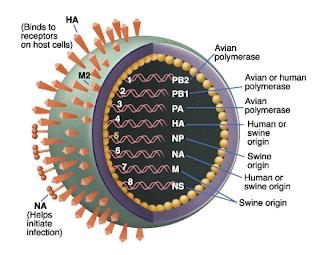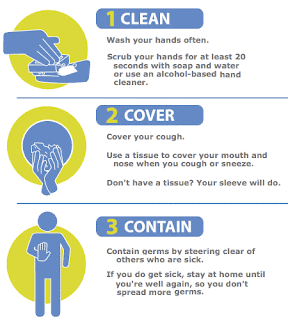What is Swine Flu?
An infection of a host animal by any one of several specific types of microscopic organisms called "swine influenza virus”.
About the Virus:
A swine influenza virus (SIV) is any strain of the influenza family of viruses that is usually hosted by (is endemic in) pigs
As of 2009, the known SIV strains are the influenza C virus and the subtypes of the influenza A virus known as H1N1, H1N2, H3N1, H3N2, and H2N3. Swine influenza is common in pigs in the United States, Mexico, Canada, South America, Europe, Kenya, and eastern Asia (namely China, Taiwan, and Japan).
The 2009 swine flu outbreak in humans is due to a new strain of influenza A virus subtype H1N1 that contains genes closely related to swine influenza. The origin of this new strain is unknown. However, the World Organization for Animal Health (OIE) reports that this strain has not been isolated in pigs. This strain can be transmitted from human to human, and causes the normal symptoms of influenza.
Pigs can become infected with human influenza, and this appears to have happened during the 1918 flu pandemic and the 2009 swine flu outbreak.
Types:
Of the three genera of influenza viruses that cause human flu, two also cause influenza in pigs, with Influenza virus A being common in pigs and Influenza virus C being rare. Influenza virus B has not been reported in pigs.
History:
1. 1918 pandemic in humans
2. 1976 U.S. outbreak
3. 1998 US outbreak in swine
4. 2007 Philippine outbreak in swine
5. 2009 outbreak in humans
Transmission to humans:
People who work with poultry and swine, especially people with intense exposures, are at increased risk of zoonotic infection (disease that normally infects other animals, but can also infect humans) with influenza virus endemic in these animals.
Other professions at particular risk of infection are veterinarians and meat processing workers
Signs and symptoms:
Prevention:
Prevention of pig to human transmission:
The transmission from swine to human is believed to occur mainly in swine farms where farmers are in close contact with live pigs. So, farmers and veterinarians are encouraged to use a face mask when dealing with infected animals. Risk factors that may contribute to swine-to-human transmission include smoking and not wearing gloves when working with sick animals.
Prevention of human to human transmission:
Influenza spreads between humans through coughing or sneezing and people touching something with the virus on it and then touching their own nose or mouth. It cannot be spread by pork products, since the virus is not transmitted through food.
The swine flu in humans is most contagious during the first five days of the illness although some people, most commonly children, can remain contagious for up to ten days.
Who are the persons at high risk?
The persons at high risk are:
• Immunocompromised persons.
• Children and old age persons
• Pregnant women
• Persons of chronic medical illness
What are the complications of swine influenza?
The complications include:
• Bronchitis
• Pneumonia
• Sinus infection
• Ear infection
How can we prevent the swine flu?




No comments:
Post a Comment